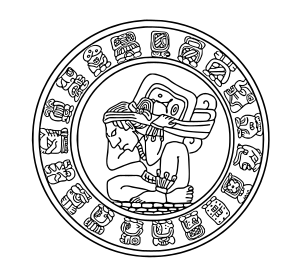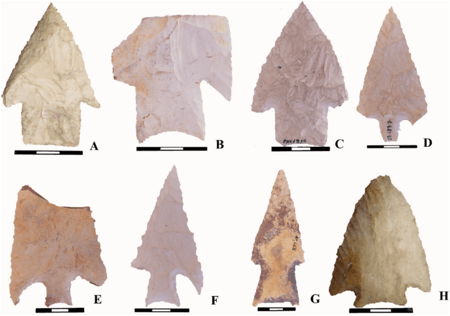Preceramic Period in Belize facts for kids
| 20000 BC – 2000 BC | |
 |
|
| Preceded by | Prehistoric Era |
|---|---|
| Including |
|
| Followed by | Preclassic Period |
The Preceramic Period in Belize and Mesoamerica was a very early time in history. It began when the first people, called Palaeoindians, arrived in the region around 20,000 BC. This period ended when the Maya started making pottery, which was around 2000 BC. The name "Preceramic" means "before ceramics" or "before pottery."
Contents
Geography of Ancient Belize
During ancient times, long before Christopher Columbus arrived, Belize was part of a large historical region called Mesoamerica. This area was home to many important civilizations, like the Maya and the Aztecs.
The Mayan region of Mesoamerica is divided into different natural areas. Belize was located in the "Mayan Lowlands." This area was mostly flat and covered in forests.
Climate Changes in Ancient Belize
As the last Ice Age ended, the climate in Belize started to change a lot. It became warmer and wetter. Large open grasslands, called savannahs, slowly turned into thick tropical forests. The sea level also rose by about 10 feet (3 meters), covering parts of the low-lying coast.
Scientists are still learning how the first Palaeoindian settlers adapted to these big changes. It's thought that as the climate got wetter, more small, freshwater animals became available. These included molluscs (like snails), turtles, and water birds. This may have led people to eat a more varied diet. Instead of just hunting large animals, they started eating many different kinds of small game and aquatic foods.
Early People in Belize
We don't have many ancient human bones from the Preceramic Period in Belize. This makes it hard to know a lot about the people who lived there. However, some remains found in caves on the Yucatan Peninsula are about 13,000 to 12,000 years old. These are the earliest signs of people in the Mayan Lowlands.
Studies of ancient DNA suggest that people came to the Mayan Lowlands from both North and South America. For example, genetic studies on bones from southern Belize show a connection to people from the Panama-Colombia region. This suggests these groups settled in southern Belize between 5500 BC and 3600 BC. They mixed with the Palaeoindian people who were already living there.
These studies also show a connection between these early people and modern Mayans. This suggests that later Mayan settlers in Belize also mixed with the existing populations. However, most scientists believe that the Palaeoindians in Belize were not the direct ancestors of the later Mayans. It's more likely that the Mayans were a different group who arrived later.
Ancient Tools and Technology
Stone Tools
During the early part of the Preceramic Period, people mainly used special stone tools called "bifaces." These were tools shaped on both sides, like Clovis-style points from North America or Fell's Cave-style "fishtail" points from South America. These points were often used as spear tips for hunting.
It's hard to figure out the exact age of these stone tools in Belize. However, recent digs in southern Belize found some bifaces that are very old. One was dated to about 10,450 to 10,085 BC. Others were dated to about 8275 to 6650 BC. Scientists are still trying to understand how these tools relate to other bifaces found in Belize.
Around 6000 BC, people in most of Belize and the Mayan Lowlands started using different kinds of stone tools. By about 3400 BC, they were using tools that were not bifaces.
In the 1980s, a project called BAAR tried to classify the stone tools found in northern Belize. However, this classification was later found to have problems. Since then, a new way of classifying these tools has been suggested.
| Phase | Type | Origin | Count | Form | Length max mean mm | Width max mean mm | Width neck mean mm | Thickness max mean mm | Notes |
|---|---|---|---|---|---|---|---|---|---|
| Allspice | Provisional | Local | 4 | Stemmed | 85.7 | 37.8 | 33.2 | 10.7 | These points have a stem. |
| Clovis | Established | North America | 3 | Fluted | 71.6 | 31.0 | 26.6 | 7.2 | These points have a groove or "flute." |
| Fishtail | Established | South America | 4 | Fluted | 63.2 | 43.7 | 25.3 | 7.1 | These points have a flared base like a fishtail. |
| Lowe | Established | Local | 63 | Stemmed | 83.5 | 55.6 | 29.0 | 9.8 | This is a common type of stemmed point. |
| Sawmill | Established | Local | 23 | Stemmed | 67.9 | 39.4 | 14.9 | 7.8 | Another type of stemmed point. |
| Ya'axche | Provisional | Local | 2 | Stemmed | 65.7 | 52.8 | 29.9 | 10.9 | A less common type of stemmed point. |
Other Technologies
Evidence of weaving, like ropes, sandals, baskets, and nets, has been found in other parts of Mesoamerica. However, these items haven't been found in Belize. This is probably because organic materials like plants and fibers don't preserve well in Belize's climate. It doesn't mean that the early settlers in Belize didn't weave.
How Early People Got Food
Scientists are still learning about what the first Palaeoindian settlers ate. Animal remains found in a cave in southern Belize suggest they ate jute snails, horses, peccaries (wild pigs), common agouti (a type of rodent), and spectacled bears.
Other sites in nearby Honduras and Mexico show that their diet also included fruits like hog plums, avocados, mammee apples, and mesquite beans. They also ate acorns, deer, birds, turtles, crabs, and snails. Some evidence even suggests they might have eaten green tomatoes, craboo, figs, rabbits, snakes, iguanas, and possibly cacao and teosinte (a wild ancestor of corn).
The early settlers are thought to have begun farming around 4500 BC. This practice became more common by 3400 BC. Plant remains from northern and central Belize show that maize (corn), cassava, chilis, squash, and beans were the main crops. People relied more and more on these farmed foods for their nutrition between 3000 BC and 1500 BC. This increased farming likely led to changes in the forests, including some deforestation.
However, studies of human bones from southern Belize suggest that corn was not a major part of the diet there before about 2750 BC. Also, animal remains from northern Belize show that people were still hunting many different animals between 3400 BC and 900 BC. These included agouti, armadillos, snakes, turtles, freshwater fish, molluscs, and possibly white-tailed deer.
Important Preceramic Sites
Most Preceramic artifacts have been found in northern and central Belize. For a long time, there were very few Preceramic findings in southern Belize. However, more discoveries have been made recently.
Generally, it's hard to find actual living spaces from the Preceramic Period in the Mayan Lowlands. But seven sites in Belize have been suggested as possible living areas. These are Saki Tzul, Mayahak Cab Pek, Tzibte Yux, Actun Halal, Caye Coco, Ladyville, and Xunantunich. Four other sites are thought to have been "working" spaces, like workshops for making stone tools. These include Colha, Kelly, Ladyville, and Callar Creek.
| Name | Location | Size |
|---|---|---|
| Actun Halal | Cayo | Small |
| August Pine Ridge | Orange Walk | Small |
| Basil Jones | Ambergris Caye | Small |
| Betz Landing | Corozal | Small |
| Blackman Eddy | Cayo | Small |
| Blue Creek | Orange Walk | Small |
| Cahal Pech | Cayo | Large |
| Callar Creek | Cayo | Small |
| Caye Coco | Corozal | Small |
| Cayo Frances Lagoon | Ambergris Caye | Small |
| Cob Swamp | Corozal | Small |
| Cobweb Swamp | Corozal | Small |
| Colha | Corozal | Small |
| Crawford Bank | Belize | Small |
| Cuello | Corozal | Small |
| Fred Smith | Corozal | Small |
| Honey Camp Lagoon | Orange Walk | Small |
| Kelly | Belize | Small |
| Ladyville | Belize | Small |
| Lowe Ranch | Belize | Small |
| Mayahak Cab Pek | Toledo | Small |
| Pulltrouser Swamp | Corozal | Small |
| Saki Tzul | Toledo | Small |
| Sand Hill | Belize | Small |
| Tzibte Yux | Toledo | Small |
| Xunantunich | Cayo | Large |
Preceramic Timeline
| Start | End | Unit | Event | Notes |
|---|---|---|---|---|
| 13000 | 12000 | BC | First Palaeoindians appear | The earliest human remains in the Lowlands are from this time. |
| 10450 | 10085 | cal BC | First biface stone tools appear | These are stone tools shaped on both sides. |
| 7000 | 7000 | BC | Last of the Ice Age megafauna | Large Ice Age animals, like horses, disappear. |
| 7000 | 6000 | BC | Last of the biface stone tools | People start using different kinds of tools. |
| 4500 | 4500 | BC | First domesticated plants | People begin to grow their own food. |
| 3400 | 3400 | BC | New types of stone tools | People start using blades and other non-biface tools. |
| 2500 | 1500 | BC | Farming becomes more common | More land is cleared for farming, leading to changes in the environment. |
| 2200 | 1900 | BC | Drought | A period of very dry weather. |
How We Learn About the Preceramic Period
The earliest studies of Preceramic artifacts from Belize were done by Augustus Pitt Rivers in 1871. He showed a flint tool found in Belize to a group of experts in London. However, at that time, most researchers were more interested in later Mayan sites.
The first major research project on the Preceramic Period in Belize started in 1980. It was called the Belize Archaic Archaeological Reconnaissance Project (BAAR). This project found about 150 possible Preceramic sites across Belize. They also dug at nine of these sites, all in northern Belize, to learn more.


